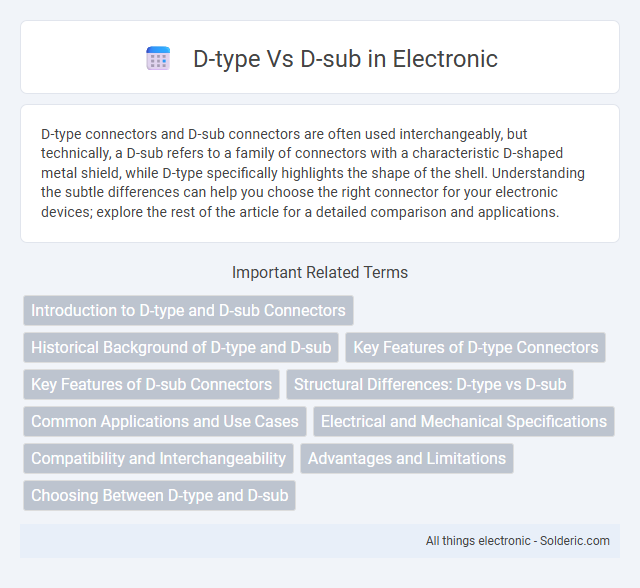D-type connectors and D-sub connectors are often used interchangeably, but technically, a D-sub refers to a family of connectors with a characteristic D-shaped metal shield, while D-type specifically highlights the shape of the shell. Understanding the subtle differences can help you choose the right connector for your electronic devices; explore the rest of the article for a detailed comparison and applications.
Comparison Table
| Feature | D-type Connector | D-sub Connector |
|---|---|---|
| Definition | Metal shell connector used for data and signal transmission. | Series of connectors with D-shaped metal shield, including D-type variants. |
| Shape | D-shaped metal shell for secure connection. | D-shaped shell with multiple pin configurations (e.g., 9, 15, 25 pins). |
| Pin Count | Varies; typically from 9 to 50 pins. | Wide range; common types include DB9, DB15, DB25. |
| Usage | Used in serial ports, VGA display connectors, and industrial systems. | Common in computer serial and parallel ports, video connectors, and industrial devices. |
| Compatibility | Subset of D-sub connectors, specific configurations. | Broader family including multiple D-type connectors. |
| Industry Standard | Part of ANSI/EIA-574 standards. | Defined under numerous standards, including MIL-DTL-24308. |
Introduction to D-type and D-sub Connectors
D-type connectors, commonly known as D-sub connectors, are widely used electrical connectors characterized by their D-shaped metal shield that provides mechanical stability and ensures proper orientation during connection. These connectors come in multiple sizes and pin configurations, making them versatile for various applications such as serial ports, parallel ports, and network interfaces. Understanding the distinction and compatibility between different D-type connector sizes helps you select the right connector for your electronic device or communication system.
Historical Background of D-type and D-sub
D-type connectors, commonly known as D-sub connectors, were developed in the early 1950s by Cannon (now ITT Cannon) to standardize connections for computer and telecommunications equipment. The D-sub's unique D-shaped metal shield prevents misalignment and ensures secure, reliable connections, which contributed to its widespread adoption in serial and parallel ports. Your understanding of electronic interface history highlights how D-type connectors revolutionized device communication by providing durable, high-density, and versatile connectivity solutions.
Key Features of D-type Connectors
D-type connectors feature a robust metal shell and a characteristic D-shaped design that ensures secure connections and prevents misalignment. They support multiple pin configurations, typically ranging from 9 to 50 pins, enabling versatile applications in data, video, and audio transmissions. High durability and reliable signal integrity make D-type connectors a popular choice in computer interfaces and industrial equipment.
Key Features of D-sub Connectors
D-sub connectors feature a trapezoidal metal shield that ensures secure, robust connections and EMI protection, with multiple pin configurations like 9, 15, 25, and 37 pins to support diverse data transfer needs. D-type refers to the connector's overall shape and shell design, encompassing the broader family of D-sub connectors used in serial ports, video interfaces, and data communication. Your selection depends on pin count and application compatibility since D-sub connectors deliver durability and reliable signal integrity in industrial and computer hardware environments.
Structural Differences: D-type vs D-sub
D-type connectors refer to a family of electrical connectors characterized by their D-shaped metal shield providing mechanical support and ensuring proper alignment. The term "D-sub" specifically denotes connectors within the D-type family that use a standardized shell size and pin configuration, often identified by a combination of letters and pin counts (e.g., DB9, DE15). Structural differences between general D-type and D-sub connectors include variations in shell size, pin density, and mounting options tailored to specific electronic interface requirements.
Common Applications and Use Cases
D-type connectors, widely used in computer serial ports and video interfaces like VGA, excel in data communication applications due to their robust design and reliable signal transmission. D-sub connectors, featuring multiple pins in a D-shaped metal shield, are prevalent in industrial equipment, telecommunications, and aerospace for their durability and ability to handle various signal types. Both connectors serve crucial roles in interfacing hardware, with D-sub often favored for complex, multi-signal setups and D-type preferred in simpler, standard data connections.
Electrical and Mechanical Specifications
D-type connectors feature a trapezoidal shell design with pins arranged in two rows, providing reliable electrical contact and resistance to electromagnetic interference. D-sub connectors, a subset of D-type, vary in pin count from 9 to 50 pins, accommodating different signal types and power requirements with standardized current ratings typically around 5A. Mechanically, both types offer robust metal shells for strain relief and secure locking mechanisms, but D-sub connectors often include shielding to enhance durability in industrial environments.
Compatibility and Interchangeability
D-type connectors and D-sub connectors share a similar shell design, but D-sub is the broader category that includes various sizes and pin configurations, making compatibility dependent on the specific D-sub subtype. You cannot interchange connectors freely since a D-type may refer to a particular size or pin count, while D-sub encompasses a range from 9 to 50 pins and beyond. Ensuring proper compatibility requires matching the exact pin arrangement and size within the D-sub family to avoid connection issues.
Advantages and Limitations
D-type connectors, commonly used in computing and telecommunications, offer secure, reliable connections with multiple pin configurations suitable for data transfer and signal applications. D-sub connectors provide a robust design with shielded metal shells that reduce electromagnetic interference but are bulkier and less flexible for compact electronic devices. Their main limitation lies in size and pin density, making D-sub less ideal for miniaturized or high-speed modern interfaces where smaller, more versatile connectors excel.
Choosing Between D-type and D-sub
When choosing between D-type and D-sub connectors, understanding that D-sub refers to the entire family of connectors characterized by D-shaped metal shields is crucial, while D-type is often used interchangeably but technically describes the connector's shape. Your decision should consider the specific pin configurations, size variations, and the device compatibility required for your application. Opt for D-sub connectors when robust shielding and reliability in signal integrity are priorities, especially in serial or parallel communication ports.
D-type vs D-sub Infographic

 solderic.com
solderic.com